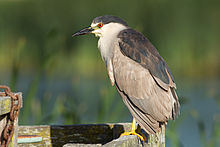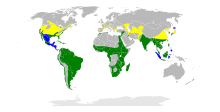Night heron
| Night heron | ||||||||||||
|---|---|---|---|---|---|---|---|---|---|---|---|---|

Night Heron ( Nycticorax n. Nycticorax ) |
||||||||||||
| Systematics | ||||||||||||
|
||||||||||||
| Scientific name | ||||||||||||
| Nycticorax nycticorax | ||||||||||||
| ( Linnaeus , 1758) | ||||||||||||
| Subspecies | ||||||||||||
|
The Night Heron ( Nycticorax nycticorax ) is a kind from the family of herons (Ardeidae) and thus belongs to the order Pelecaniformes .
The night heron is represented almost worldwide, it is only missing in Australasia . It was originally widespread in Central Europe , but is now only a relatively common breeding and summer bird in the east and south-east of Central Europe.
features
Night herons reach a body size between 58 and 65 centimeters and weigh between 727 and 1014 grams. The females are usually somewhat smaller and have a somewhat shorter head of feathers than males during the breeding season. They have a stocky build with a comparatively short neck and legs.
The plumage of the adult night heron is strikingly gray, black and white in color. Basically they have - depending on the area of distribution - a slightly different plumage color and body size. The hood , consisting of slightly elongated head and longer neck feathers, is black. The back and shoulders are also black, the belly is colored light gray to white, otherwise the torso and wings are inconspicuous ashen gray. The forehead and face are white, the thick bill is black, the iris is conspicuously red. In some places her face is featherless, the skin there is greenish-yellow. The legs of the adult night herons are pale yellow-green. The wings are wide and round. In flight they resemble the bitterns .
The young birds still have dull gray legs and their eyes are yellowish to amber . The head, neck, chest and belly are striped brown, ocher and white, while the tips of the feathers are provided with large white spots. Only when they are three years old do they get the fully colored plumage of an adult night heron.
Their general call is reminiscent of the rough, hoarse voice of a raven and sounds like qua , quak or quark . This call is usually made in flight or from a high altitude.
Occurrence
Night herons are found in Europe, Africa, Asia and America. In Central Europe they were still widespread breeding birds in the 19th century. Today they are predominantly a southern European species. They occur there in salt and brackish waters and in the marshland , also on large rivers, shallow swamps and on lake banks that are generously overgrown with rushes (Juncaceae) and cattail plants (Typhaceae).
The subspecies Nycticorax nycticorax hoactli can be found in a comparable habitat , but only on the Hawaiian Islands. However , it has never been seen on the island of Lāna'i . The subspecies Nycticorax nycticorax falklandicus is only native to the Falkland Islands and is therefore the subspecies that lives under the most extreme climatic conditions. It is basically smaller and darker feathered than other subspecies of the night heron.
behavior
Night herons are very social all year round, they are mostly found together with similar species, but also with other heron species. In winter they usually sit together on a branch. European populations are migratory birds, some non-European populations stay in the same place even in winter. When it's cold, they pull their legs in when they fly to keep warm. The young birds retreat to the nest when it is cold and crouch there. Night herons defend their feeding and nesting grounds.
nutrition
Night herons tend to search for food in the evening and at night, which means they avoid scrambling for food with diurnal heron species. When food is scarce, e.g. B. in the breeding season, they also look for food during the day. They have a very varied diet, mainly small fish , worms and insects . Occasionally they also eat crustaceans , amphibians , reptiles , mussels , rodents , birds , eggs and carrion, rarely plant materials. They keep looking for their feeding grounds.
Reproduction
In the breeding season, the legs of the monogamous night herons turn pink, two or three strikingly white, long feathers then extend from the neck to the back. During courtship , the males become more aggressive, prancing around almost crawling, crouching, clattering their bills or grabbing a branch. After the dance, they stretch their necks wide, nod their heads lower and lower until they reach the level of their feet, then they make hissing and clicking noises. The waving of a twig or the cleaning of the plumage can usually be observed between the courtship songs. It is believed that this courtship game stimulates other males to court themselves. For a species that breeds in colonies, this is critical to successful reproduction. Females that approach the courting male are initially rejected. If a female is allowed to enter the territory, the new couple cleans each other and they take turns rattling their bills. One to two days after bonding, they copulate either in the nest or close to it.
Like some other herons, such as the Canadian ( Ardea herodias ) or the little egret ( Egretta garzetta ), they breed in colonies. Around 30 nests are usually built in a tree, close to the trunk or in forks of branches. Similar to the mangrove heron ( Butorides striatus ), night herons only build a very poor nest. The male begins to build, he sets up a branch underlay or renovates an existing nest. It then brings in more twigs, roots and grass, which are then woven in by the female.
It is only incubated once a year, very rarely twice. About four to five days after copulation (late April to late June) the female lays three to five eggs at two-day intervals. On the first day they are still bright green, but they quickly fade into bluish or greenish tones. The pair incubate them alternately for about 22 to 25 days. On very hot days the adult birds moisten their plumage to keep the eggs cool. The young birds leave the nest three weeks after hatching, but they are not very far away. From three weeks on, the young birds hide high up in the treetops when they feel threatened. When they are around six to seven weeks old, they can already fly well and mark out their own territories that they already know how to defend. The adult birds usually do not recognize their young and also raise the brood of other nests.
ecology
Fisheries complain that the appearance of the night heron is very bad for fish farming as they are supposed to eat a large amount of fish. This is the reason why night herons seen close to fish hatcheries are caught or shot. However, there are now other ways to keep night herons away from the breeding tank.
When they build colonies near settlements, the night herons are said to cause great damage. That is why they are said to have been shot here, but other ways of keeping night herons away have also been developed here. They used to be hunted for their meat, but today they are almost never hunted at all.
Duration
The night heron is listed in the Red List of Germany's breeding birds in category 2 ("endangered"). It is a species in Appendix I of the EU Birds Directive (RL 79/409 / EEC). Between 1995 and 1999 35 breeding pairs were observed in Germany, from 2005 to 2009 there were only 18 to 22 breeding pairs. The central European distribution center is Hungary, where there were 3,600 breeding pairs in 2002.
A population collapse due to direct persecution and habitat destruction already occurred in the 18th and 19th centuries. Only in the second half of the 20th century did the population increase and spread into the current area. However, there was a further decline in the population afterwards. Direct pursuit again played a role, but the dry years could also have played a major role in this long-distance migrant, who crosses large desert zones in Africa. Since then, the population has increased significantly in France, among other places, and has also increased again in the rice fields of Italy. In the Netherlands, Belgium and Germany, however, populations are still very small and isolated and subject to large fluctuations.
Single receipts
- ↑ Kushlan et al., P. 259
- ^ Shirihai, p. 238
- ↑ Christoph Grüneberg, Hans-Günther Bauer, Heiko Haupt, Ommo Hüppop, Torsten Ryslavy & Peter Südbeck: Red List of Germany's Breeding Birds , 5th version, November 30, 2015 . In: Reports on bird protection . tape 52 , 2015, p. 19-67 .
- ^ Bauer et al., P. 255
- ^ Bauer et al., P. 255
literature
- Hans-Günther Bauer, Einhard Bezzel and Wolfgang Fiedler (eds.): The compendium of birds in Central Europe: Everything about biology, endangerment and protection. Volume 1: Nonpasseriformes - non-sparrow birds , Aula-Verlag Wiebelsheim, Wiesbaden 2005, ISBN 3-89104-647-2
- L. & B. Clormann: Observations in a breeding colony of the night heron (Nycticorax nycticorax). in vol. 3 nature and land. 1965.
- William E. Davis: Black-crowned night-heron. in no.74 The Birds of North America. Washington 1993.
- James A. Kushlan & James A. Hancock: Herons . Oxford University Press, 2005, ISBN 0-19-854981-4
- Hadoram Shirihai: A Complete Guide to Antarctic Wildlife - The Birds and Marine Mammals of the Antarctic Continent and Southern Ocean , Alula Press, Degerby 2002, ISBN 951-98947-0-5
Web links
- Night Heron Photos
- Nycticorax nycticorax in the endangered Red List species the IUCN 2008. Posted by: BirdLife International, 2008. Accessed January 31 of 2009.
- Videos, photos and sound recordings for Nycticorax nycticorax in the Internet Bird Collection
- Entry at the Swiss Ornithological Institute
- Feathers of the night heron





